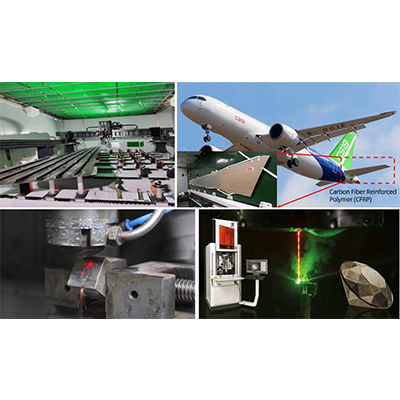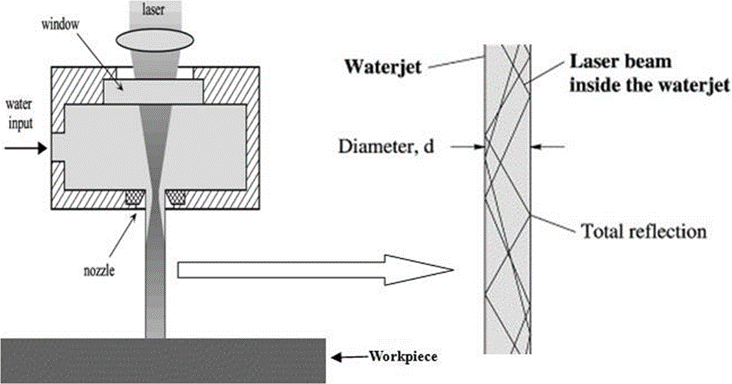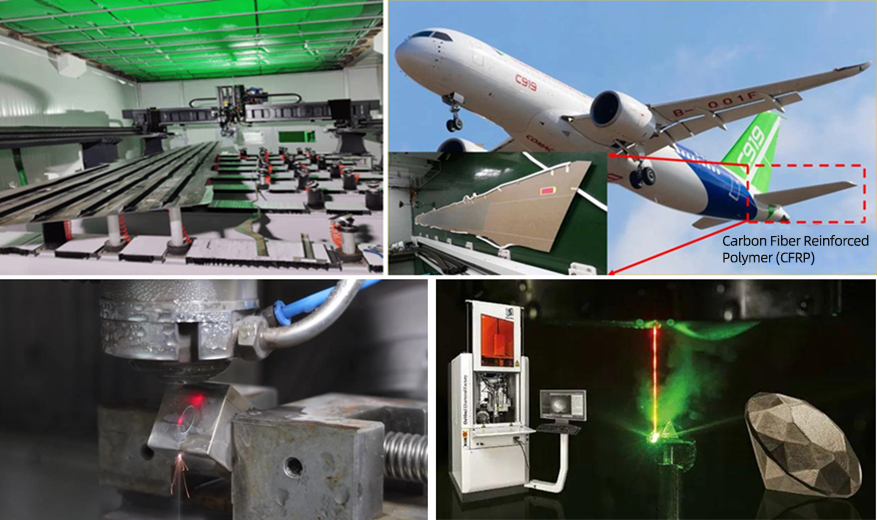
01 Technical Principle and Features
The fundamental principle of water-guided laser technology is to couple a laser beam into a high-pressure micro water jet and guide the laser through the water stream to the surface of the processing material. In such systems, the laser generated by the laser source is first collimated and focused through a series of optical components such as lenses and mirrors, and then combined with the high-pressure water jet through a special nozzle. Inside the nozzle, the water jet forms a microchannel through which the laser beam is directed to the surface of the workpiece, as shown in Figure 1. Due to the difference in refractive index between water and air, the laser’s propagation path changes in water, requiring precise optical design to ensure beam stability and energy concentration.

Figure 1. Schematic diagram of water-jet guided laser (WJGL) technology principle.
High Precision: Water-guided laser technology can achieve sub-millimeter or even micron-level machining accuracy. Because the water jet has a very small diameter, usually only tens to hundreds of microns, it can guide the laser beam precisely to specific locations on the workpiece for fine cutting, drilling, or engraving.
High Efficiency: In the water-guided laser process, the laser beam is transmitted directly to the workpiece surface through the water jet, reducing energy loss and scattering in the air. Additionally, the water jet provides cooling and flushing functions, effectively lowering the surface temperature and reducing the heat-affected zone, thus improving processing efficiency and quality.
Reduced Thermal Damage: Thanks to the cooling effect of the water stream, the heat-affected zone (HAZ) in water-guided laser processing is very small. The HAZ refers to the area where thermal deformation, damage, or phase transformation occurs due to heat conduction and radiation during laser processing. The rapid cooling effect of the water jet quickly removes surface heat, minimizing the size and depth of the HAZ and preventing thermal deformation and damage.

Figure 2. (a) SEM images of titanium alloy cuts by "conventional dry laser" (left) vs. water-jet guided laser (right); (b) Comparison of CFRP cutting surfaces: water-jet guided laser (top) vs. conventional dry laser (bottom).
02 Application Fields
Aerospace Field: Aerospace manufacturing requires extremely high processing precision and quality, making water-guided laser technology widely used. It can process key components such as engine blades, turbine disks, and combustion chambers, which are typically made from hard-to-machine materials like superalloys and titanium alloys. Water-guided laser cutting and engraving maintain precision and surface quality, enhancing part performance and reliability. It is also used for structural components such as wings and fuselages, enabling complex shapes and lightweight design.
Semiconductor Field: In semiconductor manufacturing, water-guided laser is used to cut silicon wafers, wafers, and package/test chips. Given the high precision and surface quality requirements of semiconductor materials, the low thermal damage and high precision of water-guided lasers make them ideal tools. They allow for fine wafer cutting without cracks or damage, improving yield and performance. Water-guided lasers also support micro-processing tasks such as fabricating microelectronic components and etching microcircuits, achieving micron- or even nanometer-scale precision.
New Energy Field: In the new energy sector, water-guided lasers can process key components of solar panels and fuel cells. For example, in solar panel manufacturing, they are used for cutting silicon wafers and etching electrode patterns, thereby improving photoelectric conversion efficiency and performance. In fuel cell manufacturing, they process membrane electrode assemblies and bipolar plates, enabling high-precision cutting and engraving to improve performance and lifespan.

Figure 3. Industrial applications of WJGL technology.
03 Challenges and Issues Faced by Water-Guided Lasers
Stability of Water Jet Flow: During processing, high-speed water jets may experience unstable flow, affecting processing quality. For instance, flow fluctuations during cutting may cause deviation in the cutting path or increased surface roughness, impacting accuracy and surface finish. To maintain jet stability, optimization of the control system is necessary to ensure consistent performance during operation.
Laser-Water Jet Coupling Efficiency: The coupling efficiency between the laser beam and the water jet directly affects processing results. Low coupling efficiency leads to increased energy loss in the water stream, reducing both processing efficiency and quality.
Technical Requirements for Nozzle Hole Machining: High-quality water-guided laser processing depends heavily on nozzle design and precision manufacturing. Nozzle holes must have extremely thin walls, high roundness, and no taper to withstand water impact. The inner surface roughness must be extremely low to ensure jet stability and consistency.
Environmental Adaptability: Water-guided laser equipment requires specific environmental conditions, such as stable power supply, clean water source, and constant temperature and humidity. In less controlled environments (e.g., large temperature fluctuations, high humidity, unstable power), equipment performance may degrade or fail. Dust and vibration in the surroundings may also interfere with processing accuracy and quality, so strict environmental control and management are needed.
04 Industry Development Status at Home and Abroad
With advancements in precision laser processing and growing market demand, water-guided laser technology continues to evolve. Globally, leading manufacturers of such equipment include Synova and Avonisys, both based in Switzerland. In China, rapidly growing domestic companies include Waterjet Intelligence, Cosyst, and Shanghai Lengchen Technology. Some companies have adopted the strategy of importing foreign technologies for local assembly and optimization. Although this approach quickly fills technological gaps and lowers R&D cost in the short term, it brings long-term risks, such as dependence on foreign core technologies, imbalanced R&D investment, and risks to the supply chain. A “Introduce–Absorb–Surpass” strategy is essential. Encouragingly, some Chinese companies can now offer fully localized commercial equipment with 100% domestically sourced components. As China upgrades its manufacturing industry, water-guided laser technology will play a more significant role in high-end manufacturing—particularly in new energy vehicles, aerospace, and advanced equipment manufacturing—driving technological innovation and product upgrades in these sectors.
**--Cite the article published by 高能束加工技术 on March 6, 2025, in the WeChat public account "High-Energy Beam Processing Technology and Applications."




















